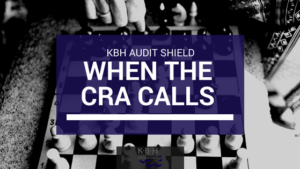As a business owner you know that there is always a chance that you will get audited after you file your tax return. When this happens one begins to wonder what ways the CRA will use to determine if your filings are legitimate. Unfortunately, this largely depends on the CRA auditor you get and if they believe your records are accurate and reliable. The CRA is also required to perform a number of indirect tests to verify that what you have earned has actually been reported, also ensuring that your expenses are accurate. The CRA usually performs tests on owner-managed, small-and mid-sized businesses. However, all types and sizes of businesses are still just as likely to be audited.
The CRA sticks with two of their tried and true testing (Indirect Verification of Income) techniques: supporting and assessing.
Supporting Techniques:
- (Bank) Deposit Analysis: You’ll be asked for all your bank statements, where the CRA will then analyze and determine whether or not the gross revenue reported and any related expenses are reasonable.
- Net Worth: Here the CRA will look into the majority of your personal funds. They will look into external factors, such as whether or not you have enough money to support your lifestyle or live in your specific area. For this the CRA will use estimates, information from your bank account(s), and information from Statistics Canada. You should be prepared to share all personal bank, investment and credit card statements, loan documents, property tax and other bills.
- Source/Application of Funds: If you’re self-employed, then this test is for you – the CRA will look at where your income comes from and compare it to what you reported
- Ratio Analysis: This is where the CRA auditor will analyze your businesses balance sheet and income statement(s), then compare the financial ratios to industry averages. The usual ratios that they inspect are gross profit and working capital. If the CRA undergoes a GST audit then they will compare revenue and expenses on the GST returns filed.
Note: don’t be alarmed if you’re asked for more information or bank statements than those listed above. It’s standard procedure for the auditor to perform a bank deposit analysis, as well as a rough net worth or source & application of funds test.
Assessing Techniques:
- Assessing technique can be used to allow the auditor to add additional taxes or make changes to a previously filed tax return.
- This allows the CRA to assess additional taxes on bank deposits, usually where the source of the income cannot be identified.
- Be careful if you think you under reported, this technique doesn’t leave much room for secrecy and you could be stuck with a “gross negligence” penalty.
We know this all sounds scary, that’s why KBH took measures to ensure we Help You Succeed. As a client of KBH Chartered Accountants we provide you with Audit Shield; so if you happen to be audited by the CRA one of our trusted business advisors will handle all communications and you don’t get stuck with any professional fees. Oh! And of course: you’re stress-free!
Contact us today for more information on any of our services: info@kbh.ca
